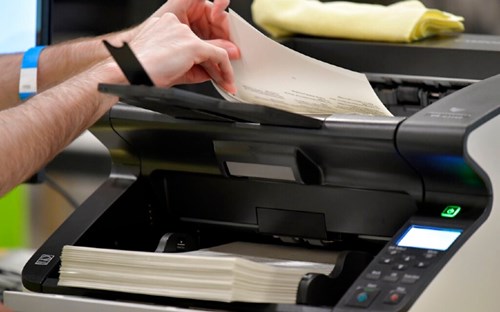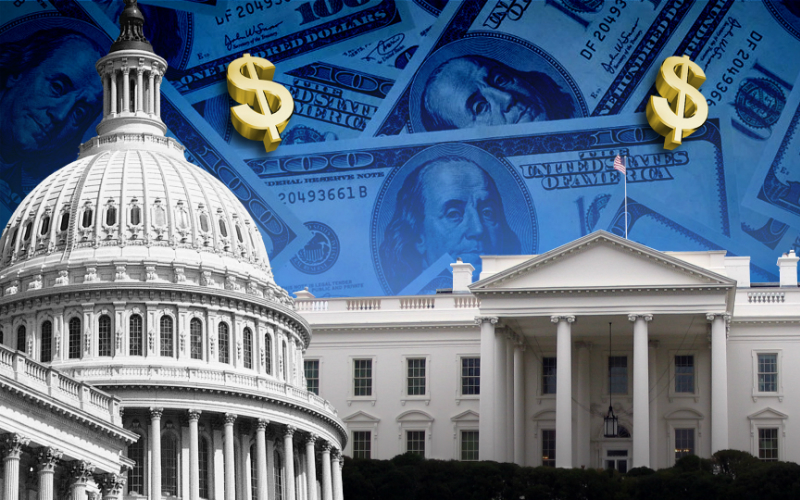The board ruled that ballots – not individual vote numbers – must be hand-counted by precinct officials to ensure they match the numbers of scanned ballots indicated on voting machines.
 Critics says the move comes at the last minute and will delay reporting results in the state.
Critics says the move comes at the last minute and will delay reporting results in the state.
Joe Biden, after a recount, won the state’s 16 electoral votes in 2020 with 49.5% to Donald Trump’s 49.3%, a difference of less than 12,000 votes.
Four years later, the state is expected to be closely contested between Trump and Kamala Harris.
The move is seen as a benefit for Trump, should it survive expected legal challenges.
In May of this year, an investigation found that Fulton County – Atlanta – had improperly double-counted some ballots. County officials received a reprimand in a jurisdiction suspected of rampant election fraud.
 Under the new rule, three separate workers at each polling place must count the ballots until all three counts are the same, Fox News reported.
Under the new rule, three separate workers at each polling place must count the ballots until all three counts are the same, Fox News reported.
If a scanner has more than 750 ballots, the count may begin on the next day.
If the numbers don’t match, the poll workers are required to identify the problem.
The measure passed with a 3-2 vote. Each board member who voted in favor was praised previously during a rally in Atlanta last month, Fox News reported.
“Why they really object is because they know that they were able to play fast and loose with the rules in Georgia in 2020,” Cleta Mitchell, an attorney and fellow with the Conservative Partnership Institute, said on American Family Radio Monday.

“They like chaos. They like it when things don't match. They like it when it's not orderly. I'm not making this up. They prefer chaos because out of chaos comes the opportunity to manipulate the outcome,” Mitchell told show host Jenna Ellis.
This hand-counting of ballots is already done in early voting, Mitchell said.
The deadline for ballots to be certified is 5 p.m. on the Monday following the election.
“Any election administrator that has a brain will make sure that those numbers are matching every day of the advance voting," ” Mitchell said. "So, all they have to do is add in the Election Day numbers, make sure they match, and not just send over to the county a bunch of numbers that don't bear any resemblance to one another."
This is security, not a revolutionary concept
It’s done in many other walks of life, she said, using the job of a bank teller and grocery clerk as an example.
"Have you ever been standing in line at the grocery store when the shift changes, and they take out one cash drawer and the other person brings her cash drawer or his cash drawer?" she said. "Those are all counted in advance before they start their shift. The numbers have to account for every transaction.”
The move was opposed by Brad Raffensperger (pictured below), the Georgia secretary of state, and by the Georgia attorney general, both Republicans.
 “The problem is that Brad Raffensperger is the secretary of state for Georgia, and he's a moron. Honestly, some of the guidance that comes out of that office, you just have to wonder what code of elections is he basing that on? It certainly isn't Georgia,” Mitchell said.
“The problem is that Brad Raffensperger is the secretary of state for Georgia, and he's a moron. Honestly, some of the guidance that comes out of that office, you just have to wonder what code of elections is he basing that on? It certainly isn't Georgia,” Mitchell said.
Critics, though, have the support of Attorney General Chris Carr. In a memo sent to election board members, Carr said no provision in state law allows counting the number of ballots by hand at the precinct level.
Therefore, the new requirement is “likely the precise kind of impermissible legislation that agencies cannot do.”
Mitchell says most counties are already using hand-counts to confirm the number of ballots in the voting machines.
“But many counties were not, and so they were all doing it differently,” she said.
A uniform policy
The board’s decision just brings about consistency throughout the state.
“This creates just a uniform procedure that everybody can know in advance that this is what they're supposed to do.
“Once the polls close on Election Day, they just have to follow these procedures," she said. "If they are planning properly and doing their work properly there shouldn't be any problem. There shouldn't be a discrepancy between what is on the tabulator and the number of ballots inside the tabulator. But if there is a discrepancy, don't we want to know that?”







